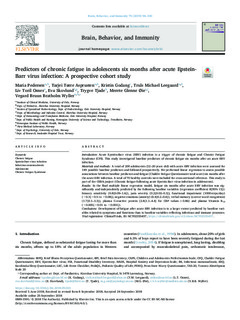| dc.contributor.author | Pedersen, Maria | |
| dc.contributor.author | Asprusten, Tarjei Tørre | |
| dc.contributor.author | Godang, Kristin | |
| dc.contributor.author | Leegaard, Truls Michael | |
| dc.contributor.author | Osnes, Liv T. N. | |
| dc.contributor.author | Skovlund, Eva | |
| dc.contributor.author | Tjade, Trygve Olav | |
| dc.contributor.author | Øie, Merete Glenne | |
| dc.contributor.author | Wyller, Vegard Bruun Bratholm | |
| dc.date.accessioned | 2019-04-25T11:18:45Z | |
| dc.date.available | 2019-04-25T11:18:45Z | |
| dc.date.created | 2018-10-02T17:34:37Z | |
| dc.date.issued | 2018 | |
| dc.identifier.citation | Brain, behavior, and immunity. 2018, 1-7. | nb_NO |
| dc.identifier.issn | 0889-1591 | |
| dc.identifier.uri | http://hdl.handle.net/11250/2595484 | |
| dc.description.abstract | Introduction
Acute Epstein-Barr virus (EBV) infection is a trigger of chronic fatigue and Chronic Fatigue Syndrome (CFS). This study investigated baseline predictors of chronic fatigue six months after an acute EBV infection.
Materials and methods
A total of 200 adolescents (12–20 years old) with acute EBV infection were assessed for 149 possible baseline predictors and followed prospectively. We performed linear regression to assess possible associations between baseline predictors and fatigue (Chalder Fatigue Questionnaire total score) six months after the acute EBV infection. A total of 70 healthy controls were included for cross-sectional reference. This study is part of the CEBA-project (Chronic fatigue following acute Epstein-Barr virus infection in adolescents).
Results
In the final multiple linear regression model, fatigue six months after acute EBV infection was significantly and independently predicted by the following baseline variables (regression coefficient B[95% CI]): Sensory sensitivity (0.8[0.09–1.6]), pain severity (0.2[0.02–0.3]), functional impairment (1000 steps/day) (−0.3[−0.5 to −0.08]), negative emotions (anxiety) (0.4[0.2–0.6]), verbal memory (correct word recognition) (1.7[0.1–3.3]), plasma C-reactive protein (2.8[1.1–4.4] for CRP values >0.86) and plasma Vitamin B12 (−0.005[−0.01 to −0.001]).
Conclusions
Development of fatigue after acute EBV infection is to a larger extent predicted by baseline variables related to symptoms and functions than to baseline variables reflecting infectious and immune processes. | nb_NO |
| dc.language.iso | eng | nb_NO |
| dc.publisher | Elsevier | nb_NO |
| dc.rights | Attribution-NonCommercial-NoDerivatives 4.0 Internasjonal | * |
| dc.rights.uri | http://creativecommons.org/licenses/by-nc-nd/4.0/deed.no | * |
| dc.title | Predictors of chronic fatigue in adolescents six months after acute Epstein-Barr virus infection: a prospective cohort study | nb_NO |
| dc.type | Journal article | nb_NO |
| dc.type | Peer reviewed | nb_NO |
| dc.description.version | publishedVersion | nb_NO |
| dc.source.pagenumber | 1-7 | nb_NO |
| dc.source.journal | Brain, behavior, and immunity | nb_NO |
| dc.identifier.doi | 10.1016/j.bbi.2018.09.023 | |
| dc.identifier.cristin | 1617372 | |
| dc.description.localcode | © 2018 The Author(s). Published by Elsevier Inc. This is an open access article under the CC BY-NC-ND license (http://creativecommons.org/licenses/BY-NC-ND/4.0/) | nb_NO |
| cristin.unitcode | 194,65,20,0 | |
| cristin.unitname | Institutt for samfunnsmedisin og sykepleie | |
| cristin.ispublished | false | |
| cristin.fulltext | postprint | |
| cristin.qualitycode | 2 | |

